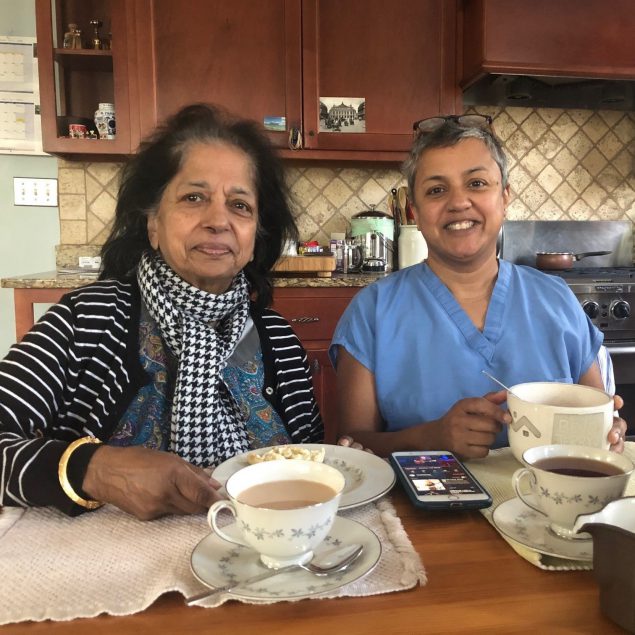Recommendations for Fully Vaccinated People
COVID-19 Homepage
Revealing the Many Faces of COVID-19

CDC's Deblina Datta (r.) hosted her mother Chitra Datta early in the pandemic. Chitra lives in New York, and when COVID-19 first broke out there, she took refuge at her daughter's Atlanta home, where Deblina teleworked, leading a clinical team on CDC's COVID-19 emergency response.
People can survive a COVID-19 infection in the lungs only to come down with new symptoms in other parts of the body. This is yet another way that COVID-19 is a particularly bad viral disease, says Deblina Datta, a CDC doctor who researches how infectious diseases make people sick.
Deblina has spent more than nine months on CDC’s COVID-19 emergency response, mostly leading a team of more than 40 clinicians concentrating on healthcare and protecting workers during the pandemic. She has spent decades trying to stop the spread of viral diseases like AIDS and hepatitis. But during her time on the response, she found the virus that causes COVID-19 to cause more ailments than nearly any other disease she knows.
“It’s like an excavation where you constantly unearth new artifacts,” says Deblina, who also holds the rank of captain in the U.S. Public Health Service.
Some people who caught COVID-19 but never got respiratory symptoms suffered extreme fatigue, difficulty concentrating, heart damage, or inflamed organs. Symptoms could last weeks or months.
Before the pandemic, Deblina was part of the CDC mission to eradicate the last remnants of polio. For 10 years, she trekked with teams through brushland, rivers, and jungles to remote villages, where she saw many people debilitated by the disease. Though it attacks the spinal cord and causes paralysis, polio is more straightforward than COVID-19.
“After a polio infection, there’s a remote possibility the patient might get a post-polio syndrome,” she says. But COVID-19 can have many follow-on illnesses, and they are more common.”
When COVID-19 came to the United States, Deblina’s mother fled the surging outbreak in New York City to stay in Atlanta with Deblina, who soon started working from home. She and her team worked on the pandemic six to seven days a week, analyzing data into the night and writing studies on disease symptoms they and other clinicians encountered.
“In the very beginning, COVID-19 looked like a very powerful flu, but that changed quickly and by a lot,” Deblina says. “One of the early surprises we saw was a number of people having strokes, and that is definitely not something you see with a flu. That was a turning point in my understanding. I knew there was a lot more going on.”
The team saw blood clots caused by COVID-19 in various parts of patients’ bodies. The clots were likely related to the strokes, which are often caused by a blood clot lodging in a blood vessel in or near the brain. Then the team began seeing more disorders, and that was a bad sign.
“Viruses that keep attacking in different ways and later, when the main infection is gone, are rare. It’s a hallmark of viruses that are particularly bad, but other viruses that do this are not nearly as contagious as the one that causes COVID-19,” Deblina says.
As research progressed, her team observed that some children exposed to the virus came down with what’s now known as multisystem inflammatory syndrome in children (MIS-C). MIS-C can inflame organs like the heart, lungs, intestines, or skin, and it causes fever. A related inflammatory syndrome later appeared in adults, claiming the lives of some people who had recovered from COVID-19’s respiratory symptoms.
“We saw kidney damage and neurological disturbances. In autopsied heart tissue from patients who died, we found inflammation in lots of tiny blood vessels. COVID-19 has been linked to heart failure, including in young, healthy adults and in children,” Deblina says.
In October, Deblina’s mother returned to New York, where the outbreak was no longer as bad, but Deblina’s workload hardly relented. The collection of symptoms her team documented resembled an asteroid impact, where the respiratory illness was the crater and many other disorders surrounded it like debris. The researchers uncovered few signals to indicate which people with COVID-19 are likely to come down with delayed or long-term ailments.
“When I expect this virus to zig, it zags,” Deblina says. “It’s not like you can say, ‘This person was in the ICU, so we knew they were at high risk for long-term debilitating symptoms.’”
Deblina and her team have also witnessed much progress. New treatments are saving more lives, including of patients on ventilators.
Clinicians also now know better who is likely to be re-admitted to hospital for a COVID-19 infection, and they’re working to reduce relapses. Public health guidance like masking and medical advancements like mRNA vaccine technology are working, and they will improve the fight against future disease outbreaks. Cases where people have recovered from the disease only to be reinfected remain “really rare,” she says.
And as an expert in vaccines, Deblina attests to their effectiveness. She used them to drive down polio outbreaks and was involved in recommendations for the development of a vaccine against human papillomavirus infections (HPV), a sexually transmitted disease.
“Vaccines can save the day, and everyone who can get a COVID-19 vaccine should,” Deblina says.